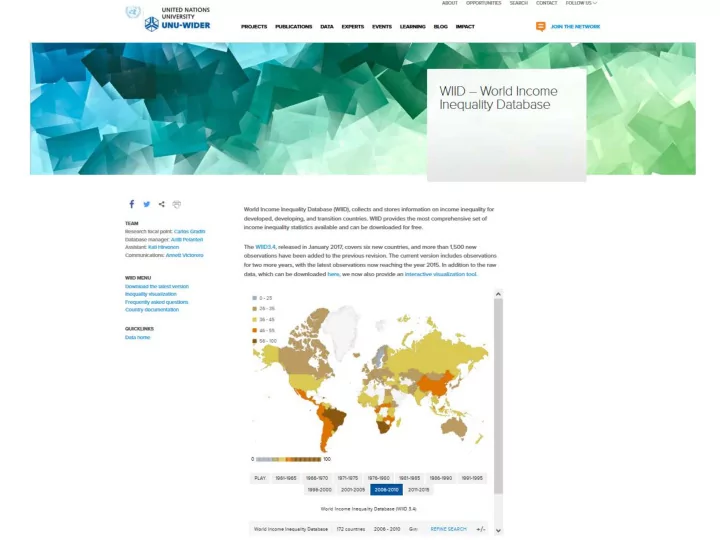

1
Inequality • Growing public concern on income inequality: – Global, regional, country level • ... that often faces the lack of adequate data: – Especially for developing countries (e.g. MENA and sub-Saharan countries), – … for long–term series, – … for comparisons across countries. – Limited information, dispersed across many sources, not always easily accessible, and with many comparability issues. 2
“ Empirical work using cross-country data to draw inferences regarding the relationship between growth and inequality has a long tradition […]. The lack of time series that are sufficiently long has prevented appropriate testing of these hypotheses. Furthermore, problems in the quality of data and the fact that existing measures are often based on different definitions hamper comparability between countries-and often even within the same country over time - thus affecting empirical results in unpredictable ways.” Deininger and Squire (World Bank Economic Review, 1991: pp 565-566) 3
WIID • A database with cross-country information on income inequality, stored in an organized and user-friendly manner and accessible in a systematic way. • It is part of the World Inequality project (current 2014–18 UNU- WIDER programme), • … but has been an essential element of UNU-WIDER across different work programmes: – Initially compiled in 1997–99, published as WIID 1.0 (Sept. 2000). – Subsequently updated and expanded; current WIID 3.4 (January 2017). Currently working on a major revision with enhanced features. • 4
WIID • Gini, Deciles/Quintiles, Bottom/Top 5%, Mean/Median, with description of source, concept, coverage, … • Secondary data, using several sources (old and new): – Initial compilations: Jain; Deininger and Squire (WB); Altimir/ECLAC; Transmonee; Dowling and Soo (ADB) … – Repositories: LIS, SEDLAC, Eurostat, World Bank, OECD, ECLAC, … – National statistical offices. – Research papers and reports. 5
WIID • Playing an important role in research: • Global inequality and poverty: – Sala i Martin (Quaterly J. Economics, 2010); – Ackland et al. (R. Economics and Statistics, 2013); – Niño-Zarazúa and Tarp (R. Income and Wealth, 2017); – Roope et al. (Economics Letters, 2018). 6
WIID • Relationship of inequality with issues such as: – economic growth : Jovanovic (Economic Systems, 2018), Also: – foreign direct investment : Huang et al. (R. World Economics, 2010) – real exchange rate : Min et al. (Annals of Economics and Finance, 2015). – institutional development : Amendola et al. (Public Chice, 2013) – labor regulations : Alesina et al. (J. Economic Growth, 2018) – economic sanctions : Afesorgbor and Mahadevan (World Development, 2018) – public sector expansion : Lee et al. (American Sociological R., 2011) – political conflict : Cramer & Kaufman (Comparative Political Studies, 2011) – religiosity : Immerzeel and Tubergen (European Sociological R., 2013) – skilled immigration : Kahanec and Zimmermann (IZA J. Migration, 2015) 7
WIID • Increasing number of complementary or competing databases with different features: – Two databases largely based on WIID: • the Standardized World Income Inequality Database (SWIID). • the Global Consumption and Income Project (GCIP). – Other resources: 8
WIID – Ex-ante harmonization: • Eurostat's European Community Household Panel (ECHP) and European Union Statistics on Income and Living Conditions (EU-SILC) for European countries. • World Bank’s Living Standards Measurement Study (LSMS) – Ex-post harmonization: • Luxembourg Income Study (LIS). • Socio-Economic Database for Latin America and the Caribbean (SEDLAC by CEDLAS/World Bank), • PovcalNet (WB), ‘All the Ginis’, OECD, … – Other specialized databases (top incomes and/or wealth): • World Inequality Lab, Credit Suisse. 9
WIID • Critical appraisals of cross-national income inequality databases: • Atkinson and Brandolini, 2001. • Journal of Economic Inequality, 2015 (edited by F. Ferreira and N. Lustig). • Galbraith et al. (Research on Labor Economics, 2016). • WIID: Limitations and advantages • Limited information (no microdata); heterogeneity of data sources, wellbeing definitions, methodologies: – need for harmonization /careful selection by users. • Accessibility and transparency (widely used); largest possible geographical and time coverage, especially for developing countries. 10
WIID • Future, improving the harmonization and accessibility – Continuous update. – Improving estimates: • E.g. when Ginis are missing or based on grouped data and we have information on income shares. • Correction for under-reporting in top incomes – Selection and standardization the different Ginis: • Making comparable Ginis using different wellbeing concepts (income vs consumption; per capita vs equivalized; area coverage) – Improving the information displayed in the website (documentation, visualization tools, analysis) 11
Observations by country´s income group WIID 6,000 5,626 5,000 4,000 • About 11,000 observations frequency • 191 countries/historical entities. 3,187 3,000 2,000 1,814 1,000 257 0 Low Lower middle Upper middle High No data for: • Libya, North Korea • Some Gulf states (Bahrain, Brunei, UAE, Kuwait) • Some microstates (Monaco, Vatican City, Grenada, S. Marino …) • West Sahara, French Guiana 12
All countries 500 400 (1867) 1950-2017 300 Frequency 200 100 0 1940 1960 1980 2000 2020 year 13
Sub-Saharan Africa 25 538 obs. 20 Frequency 15 10 5 0 1940 1960 1980 2000 2020 year 14
MENA countries 20 313 obs. 15 Frequency 10 5 0 1940 1960 1980 2000 2020 year 15
www.wider.unu.edu Helsinki, Finland
Recommend
More recommend